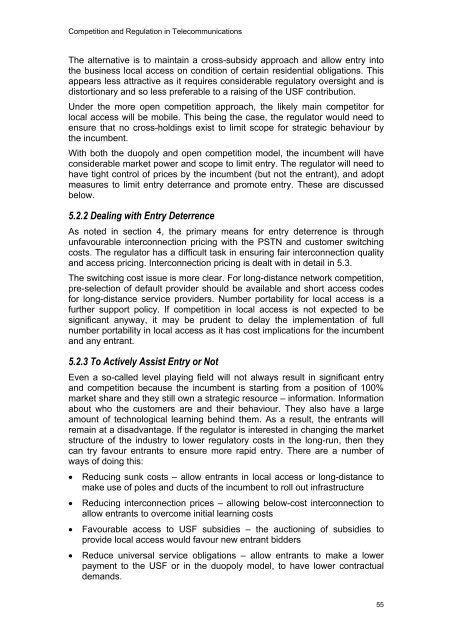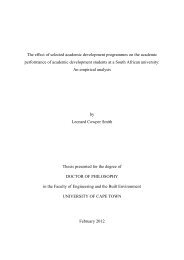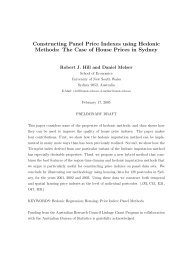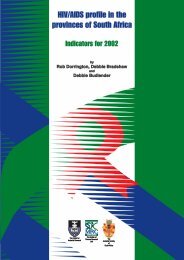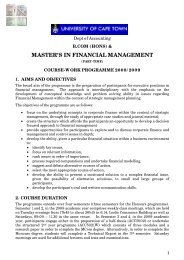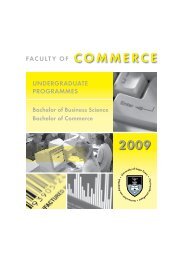Competition and Regulation in the Telecommunications Industry in ...
Competition and Regulation in the Telecommunications Industry in ...
Competition and Regulation in the Telecommunications Industry in ...
Create successful ePaper yourself
Turn your PDF publications into a flip-book with our unique Google optimized e-Paper software.
<strong>Competition</strong> <strong>and</strong> <strong>Regulation</strong> <strong>in</strong> <strong>Telecommunications</strong>The alternative is to ma<strong>in</strong>ta<strong>in</strong> a cross-subsidy approach <strong>and</strong> allow entry <strong>in</strong>to<strong>the</strong> bus<strong>in</strong>ess local access on condition of certa<strong>in</strong> residential obligations. Thisappears less attractive as it requires considerable regulatory oversight <strong>and</strong> isdistortionary <strong>and</strong> so less preferable to a rais<strong>in</strong>g of <strong>the</strong> USF contribution.Under <strong>the</strong> more open competition approach, <strong>the</strong> likely ma<strong>in</strong> competitor forlocal access will be mobile. This be<strong>in</strong>g <strong>the</strong> case, <strong>the</strong> regulator would need toensure that no cross-hold<strong>in</strong>gs exist to limit scope for strategic behaviour by<strong>the</strong> <strong>in</strong>cumbent.With both <strong>the</strong> duopoly <strong>and</strong> open competition model, <strong>the</strong> <strong>in</strong>cumbent will haveconsiderable market power <strong>and</strong> scope to limit entry. The regulator will need tohave tight control of prices by <strong>the</strong> <strong>in</strong>cumbent (but not <strong>the</strong> entrant), <strong>and</strong> adoptmeasures to limit entry deterrance <strong>and</strong> promote entry. These are discussedbelow.5.2.2 Deal<strong>in</strong>g with Entry DeterrenceAs noted <strong>in</strong> section 4, <strong>the</strong> primary means for entry deterrence is throughunfavourable <strong>in</strong>terconnection pric<strong>in</strong>g with <strong>the</strong> PSTN <strong>and</strong> customer switch<strong>in</strong>gcosts. The regulator has a difficult task <strong>in</strong> ensur<strong>in</strong>g fair <strong>in</strong>terconnection quality<strong>and</strong> access pric<strong>in</strong>g. Interconnection pric<strong>in</strong>g is dealt with <strong>in</strong> detail <strong>in</strong> 5.3.The switch<strong>in</strong>g cost issue is more clear. For long-distance network competition,pre-selection of default provider should be available <strong>and</strong> short access codesfor long-distance service providers. Number portability for local access is afur<strong>the</strong>r support policy. If competition <strong>in</strong> local access is not expected to besignificant anyway, it may be prudent to delay <strong>the</strong> implementation of fullnumber portability <strong>in</strong> local access as it has cost implications for <strong>the</strong> <strong>in</strong>cumbent<strong>and</strong> any entrant.5.2.3 To Actively Assist Entry or NotEven a so-called level play<strong>in</strong>g field will not always result <strong>in</strong> significant entry<strong>and</strong> competition because <strong>the</strong> <strong>in</strong>cumbent is start<strong>in</strong>g from a position of 100%market share <strong>and</strong> <strong>the</strong>y still own a strategic resource – <strong>in</strong>formation. Informationabout who <strong>the</strong> customers are <strong>and</strong> <strong>the</strong>ir behaviour. They also have a largeamount of technological learn<strong>in</strong>g beh<strong>in</strong>d <strong>the</strong>m. As a result, <strong>the</strong> entrants willrema<strong>in</strong> at a disadvantage. If <strong>the</strong> regulator is <strong>in</strong>terested <strong>in</strong> chang<strong>in</strong>g <strong>the</strong> marketstructure of <strong>the</strong> <strong>in</strong>dustry to lower regulatory costs <strong>in</strong> <strong>the</strong> long-run, <strong>the</strong>n <strong>the</strong>ycan try favour entrants to ensure more rapid entry. There are a number ofways of do<strong>in</strong>g this:• Reduc<strong>in</strong>g sunk costs – allow entrants <strong>in</strong> local access or long-distance tomake use of poles <strong>and</strong> ducts of <strong>the</strong> <strong>in</strong>cumbent to roll out <strong>in</strong>frastructure• Reduc<strong>in</strong>g <strong>in</strong>terconnection prices – allow<strong>in</strong>g below-cost <strong>in</strong>terconnection toallow entrants to overcome <strong>in</strong>itial learn<strong>in</strong>g costs• Favourable access to USF subsidies – <strong>the</strong> auction<strong>in</strong>g of subsidies toprovide local access would favour new entrant bidders• Reduce universal service obligations – allow entrants to make a lowerpayment to <strong>the</strong> USF or <strong>in</strong> <strong>the</strong> duopoly model, to have lower contractualdem<strong>and</strong>s.55


